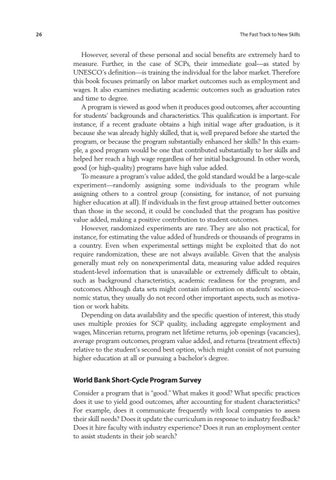26
The Fast Track to New Skills
However, several of these personal and social benefits are extremely hard to measure. Further, in the case of SCPs, their immediate goal—as stated by UNESCO’s definition—is training the individual for the labor market. Therefore this book focuses primarily on labor market outcomes such as employment and wages. It also examines mediating academic outcomes such as graduation rates and time to degree. A program is viewed as good when it produces good outcomes, after accounting for students’ backgrounds and characteristics. This qualification is important. For instance, if a recent graduate obtains a high initial wage after graduation, is it because she was already highly skilled, that is, well prepared before she started the program, or because the program substantially enhanced her skills? In this example, a good program would be one that contributed substantially to her skills and helped her reach a high wage regardless of her initial background. In other words, good (or high-quality) programs have high value added. To measure a program’s value added, the gold standard would be a large-scale experiment—randomly assigning some individuals to the program while assigning others to a control group (consisting, for instance, of not pursuing higher education at all). If individuals in the first group attained better outcomes than those in the second, it could be concluded that the program has positive value added, making a positive contribution to student outcomes. However, randomized experiments are rare. They are also not practical, for instance, for estimating the value added of hundreds or thousands of programs in a country. Even when experimental settings might be exploited that do not require randomization, these are not always available. Given that the analysis generally must rely on nonexperimental data, measuring value added requires student-level information that is unavailable or extremely difficult to obtain, such as background characteristics, academic readiness for the program, and outcomes. Although data sets might contain information on students’ socioeconomic status, they usually do not record other important aspects, such as motivation or work habits. Depending on data availability and the specific question of interest, this study uses multiple proxies for SCP quality, including aggregate employment and wages, Mincerian returns, program net lifetime returns, job openings (vacancies), average program outcomes, program value added, and returns (treatment effects) relative to the student’s second best option, which might consist of not pursuing higher education at all or pursuing a bachelor’s degree.
World Bank Short-Cycle Program Survey Consider a program that is “good.” What makes it good? What specific practices does it use to yield good outcomes, after accounting for student characteristics? For example, does it communicate frequently with local companies to assess their skill needs? Does it update the curriculum in response to industry f eedback? Does it hire faculty with industry experience? Does it run an employment center to assist students in their job search?

